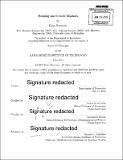Housing and credit markets
Author(s)
Struyven, Daan; Koulischer, François
DownloadFull printable version (18.83Mb)
Alternative title
Essays on housing and credit markets
Other Contributors
Massachusetts Institute of Technology. Department of Economics.
Advisor
James M. Poterba and Antoinette Schoar.
Terms of use
Metadata
Show full item recordAbstract
This thesis consists of three chapters on housing and credit markets. Chapter 1 tests the "housing lock hypothesis": the conjecture that homeowners with limited or negative home equity, low levels of financial assets and restricted opportunities to borrow are unable to move. It employs unique, administrative population data on residential location, home-ownership, family structure, and household balance sheets from the Netherlands. The rapid rise in Dutch house prices during the 1995- 2008 period, and their substantial decline thereafter, has generated large variation in the home equity of buyers who bought homes a few years apart. Buyers in the cohorts that purchased homes around the peak have higher Loan-To-Value (LTV) ratios than earlier buyers, and also have much lower mobility rates in every year after purchase. A decline in home equity is associated with large and statistically significant reductions in household mobility. A rise in the LTV ratio from 90 to 115% is associated with a 30% decline in household mobility. The reduction in mobility is observed both within and across labor markets. The mobility effects of falling home equity are substantially larger for households with low financial asset holdings. These results emerge from comparisons of mobility rates from different purchase cohorts after removing time and region effects, as well as from an analysis of homebuyers whose purchase timing was determined by arguably exogenous changes in family structure. Since Dutch mortgages are full recourse, which rules out strategic default behavior, the findings provide new support for the "housing lock hypothesis". Chapter 2, co-authored with François Koulischer, studies the role of collateral in liquidity provision by central banks. Should central banks lend against low quality collateral? We characterize efficient central bank collateral policy in a model where a bank borrows from the interbank market or the central bank. Collateral has favorable incentive effects but is costly to transfer to lenders who value the collateral less because of imperfect collateral quality. We show that a fall in the quantity or the quality of the bank's collateral can increase interest rates in the economy even with a constant policy rate. A looser central bank collateral policy can reduce the spread, alleviate the credit crunch and increase output. Chapter 3 studies the effects of LTV limits, Payment-To-Income (PTI) limits and the mortgage interest deduction on mortgage debt exploiting a series of policy changes in the Netherlands. As intended, regulatory loan limits reduce mortgage leverage ratios and they also induce bunching at the loan limits. Loan limits and restrictions of the mortgage interest deduction trigger large declines in mortgage volumes. The leverage and volume responses are larger for young, borrowing-constrained households. The repeal of the mortgage interest deduction for non-amortizing mortgages decimates the market for non-amortizing mortgages. The PTI tightening is also associated with a substantial rise in the fraction of mortgages that have very short periods during which the interest rate is fixed. This unintended risk-shifting pattern to quasi- adjustable-rate mortgages (ARM) may increase income risk. The reform of the mortgage interest deduction, which boosts amortization, is also associated with a significant decline in principal amounts at origination. These findings highlight the distributional effects as well as the unintended potential consequences of macroprudential and fiscal policies aiming to reduce mortgage debt. This thesis tries to cast light on the effects of shocks to the value of housing and other types of collateral on the broader economy. This work suggests that the combination of imperfections in credit markets and shocks to asset prices can exert a substantial, non-linear and heterogeneous influence on household and firm outcomes, such as residential mobility (Chapter 1) and business investment (Chapter 2). This thesis also investigates the role for monetary, macroprudential and fiscal policies to alleviate or prevent the negative spill-over effects to the real economy, both before (Chapter 3) as well as after (Chapter 2) the occurrence of financial shocks.
Description
Thesis: Ph. D., Massachusetts Institute of Technology, Department of Economics, 2015. Title as it appears in MIT Commencement Exercises program, June 5, 2015: Essays on housing and credit markets. Chapter 2 co-authored by François Koulischer. Cataloged from PDF version of thesis. Includes bibliographical references (pages 117-125).
Date issued
2015Department
Massachusetts Institute of Technology. Department of EconomicsPublisher
Massachusetts Institute of Technology
Keywords
Economics.